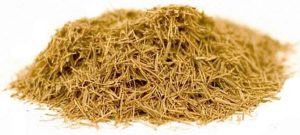Cat’s claw is a plant. Two species of cat’s claw, Uncaria tomentosa and Uncaria guianensis, are of primary interest for use as medicine. Uncaria tomentosa is most commonly used in the U.S., and Uncaria guianensis is typically used in Europe. Medicine is made from the root and bark. Cat’s claw was ranked as the seventh most popular herb in U.S. sales in 1997. Be careful not to confuse cat’s claw with cat’s foot.
Contents
Uses
Cat’s claw has a history of folklore use in South America for wound healing and for treating arthritis, stomach ulcers, intestinal disorders, and some skin disorders and tumors. The part used medicinally is the inner bark of the vine or root. In Peru, a boiled water extract of U. guianensis is used for inflammation, arthritis, and contraception, as well as for treating stomach ulcers and tumors, gonorrhea (by the Bora tribe), diarrhea (by the Indian populations of Colombia and Guiana), and cancers of the urinary tract in women. The Ashanica Indians believe that samento (U. tomentosa) has life-giving properties and ingest a cup of the extracts every 1 to 2 weeks to ward off disease, treat bone pain, and cleanse the kidneys. Other reported uses include treatment for abscesses, asthma, chemotherapy adverse effects, fever, bleeding, rheumatism, skin impurities, urinary tract inflammation, weakness, and wounds, as well as for disease prevention and recovery from childbirth.
Benefits
Cat’s claw is most commonly used for improving symptoms of both osteoarthritis and rheumatoid arthritis.
It is also used for various digestive system disorders including swelling and pain (inflammation) of the large intestine (diverticulitis), inflammation of the lower bowel (colitis), inflammation of the lining of the stomach (gastritis), stomach ulcers,hemorrhoids, and leaky bowel syndrome.
Some people use cat’s claw for viral infections including shingles (caused by herpeszoster), cold sores (caused by herpes simplex), and AIDS (caused by human immunodeficiency virus (HIV)).
Cat’s claw is also used for chronic fatigue syndrome (CFS), wound healing, parasites, Alzheimer’s disease, asthma, hay fever, cancer (especially urinary tract cancer), a particular type of brain cancer called glioblastoma, gonorrhea, dysentery, birth control, bone pains, and “cleansing” the kidneys.
Cautions
Cat’s claw is POSSIBLY SAFE for most people, when taken by mouth short-term. However, it can cause headache, dizziness, and vomiting in some people.
Special Precautions & Warnings:
Pregnancy and breast-feeding: There is some concern that cat’s claw isPOSSIBLY UNSAFE during pregnancy when taken by mouth. Not enough is known about the safety of cat’s claw during breast-feeding. Avoid using cat’s claw if you are pregnant or breast-feeding.
“Auto-immune diseases” such as multiple sclerosis (MS), lupus (systemic lupus erythematosus, SLE), or other similar conditions: Cat’s claw might cause the immune system to become more active. This could increase the symptoms of auto-immune diseases. If you have one of these conditions, it’s best to avoid using cat’s claw without consulting with your healthcare provider.
Bleeding disorders: Cat’s claw might slow blood clotting. There is concern that cat’s claw might increase the risk of bruising or bleeding in people with bleeding disorders.
Low blood pressure: Low blood pressure: There is some evidence that cat’s claw might lower blood pressure. If your blood pressure is already too low, this might be a problem.
Leukemia: Cat’s claw might worsen this condition. Don’t use it if you have leukemia.
Surgery: There is a concern that cat’s claw might make blood pressure control difficult during surgery. Stop taking cat’s claw at least 2 weeks before a scheduled surgery.
Interactions
- Medications changed by the liver (Cytochrome P450 3A4 (CYP3A4) substrates) interacts with CAT’S CLAW
Some medications are changed and broken down by the liver.Cat’s claw might decrease how quickly the liver breaks down some medications. Taking cat’s claw along with some medications that are broken down by the liver can increase the effects and side effects of some medications. Before taking cat’s claw, talk to your healthcare provider if you are taking any medications that are changed by the liver.
Some medications changed by the liver include lovastatin (Mevacor), ketoconazole (Nizoral), itraconazole (Sporanox), fexofenadine (Allegra), triazolam (Halcion), and many others.
- Medications for high blood pressure (Antihypertensive drugs) interacts with CAT’S CLAW
Cat’s claw seems to decrease blood pressure. Taking cat’s claw along with medications for high blood pressure might cause your blood pressure to go too low.Some medications for high blood pressure include captopril (Capoten), enalapril (Vasotec), losartan (Cozaar), valsartan (Diovan), diltiazem (Cardizem), Amlodipine (Norvasc), hydrochlorothiazide (HydroDiuril), furosemide (Lasix), and many others.
- Medications that decrease the immune system (Immunosuppressants) interacts with CAT’S CLAW
Cat’s claw might increase the immune system. By increasing the immune system cat’s claw might decrease the effectiveness of medications that decrease the immune system.Some medications that decrease the immune system include azathioprine (Imuran), basiliximab (Simulect), cyclosporine (Neoral, Sandimmune), daclizumab (Zenapax), muromonab-CD3 (OKT3, Orthoclone OKT3), mycophenolate (CellCept), tacrolimus (FK506, Prograf), sirolimus (Rapamune), prednisone (Deltasone, Orasone), corticosteroids (glucocorticoids), and others.
Other names
Griffe du Chat, Liane du Pérou, Life-giving Vine of Peru, Samento, Uña de Gato, Uncaria guianensis, Uncaria tomentosa
References
Drugs.com, http://www.drugs.com/npc/cat-s-claw.html

